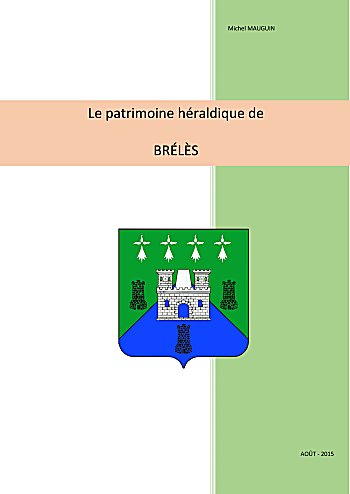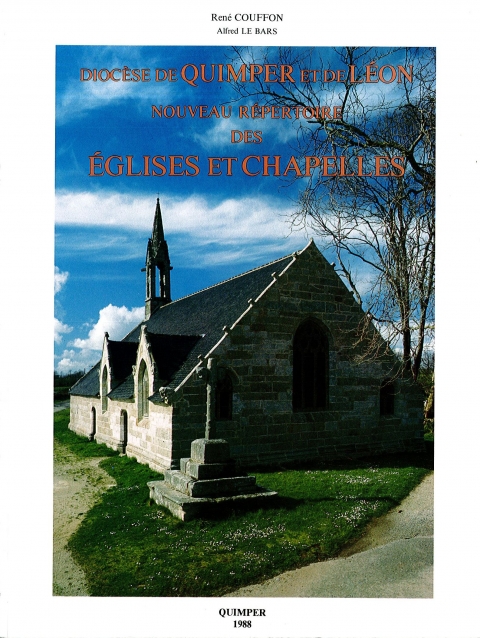Saint-Rivoaré Church
( Municipality of Lanrivoaré)

GPS : 48°28'27.7 N 4°38'19.1 W
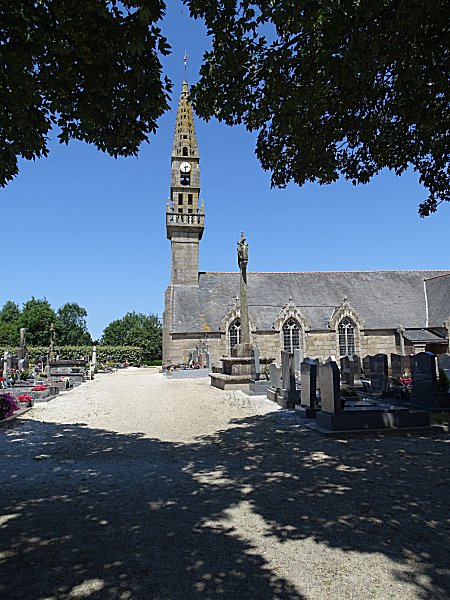
Access :
From St-Renan, take the D68 road towards Ploudalmézeau.
After 4 km, at the roundabout, turn right, enter Lanrivoaré and turn right again towards the church.
Park on the large parking lot in front of the church enclosure.
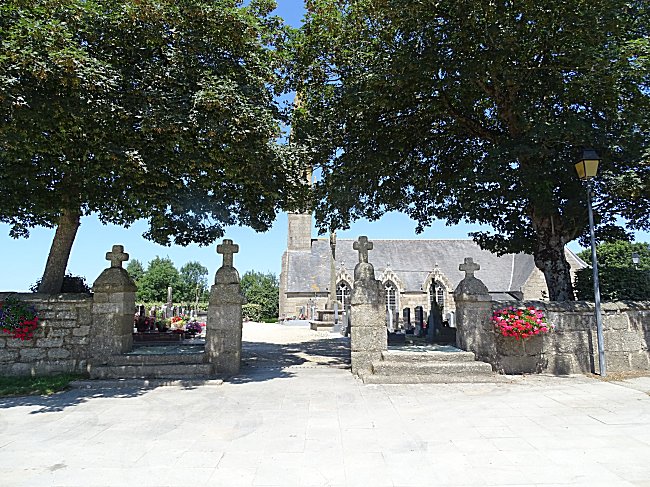
The central entrance of the parish enclosure was once framed by two stones set on edge1
of which only the steps remain.
Lanrivoaré takes its name from the Breton lann, hermitage, and from Rivoaré, Riwall or Rivoal the name of the saint to whom the church is dedicated. Prince or king become priest, born across the Channel at the fall of the Roman Empire, he would have been the first evangelizer of Armorica. Tradition has it that his small community of migrants would have been massacred by the pagans and that the bodies have been buried in the Cemetery of Saints, at the foot of the present church. (
The Saints Cemetery )
He would have been the maternal uncle of Saint Hervé, the anchorite to whom we attribute the hermitage located in the neighbouring woods.
(
The hermitage of Saint Hervé )
The building:
The church is located in a parish enclosure that also includes the communal cemetery, a XVIIth century calvary and the Saints Cemetery. The building, in the shape of a cross, dates from 1583. It underwent reconstructions and enlargements in 1727 and 1744.
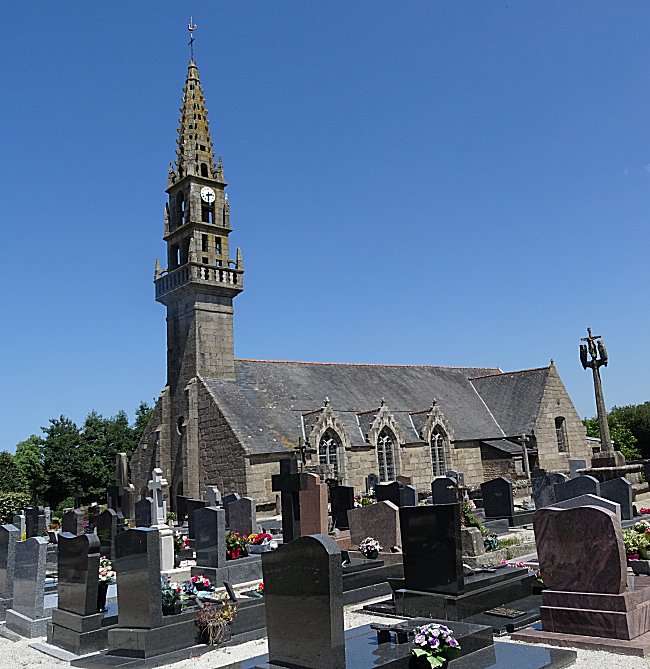
Access to the bell tower is from the outside.
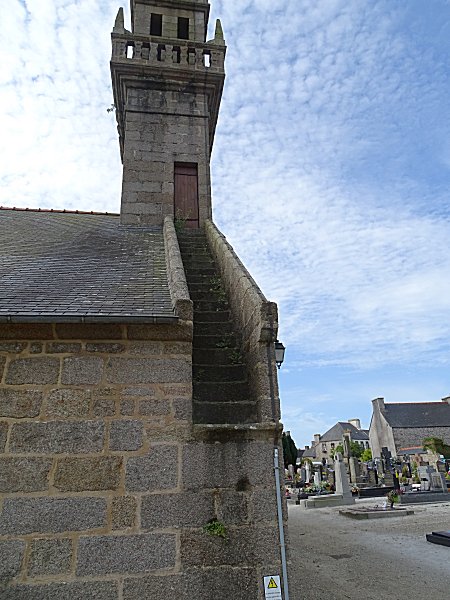
It has a gallery surmounted by two bell chambers and an octagonal, openwork hooked spire. At the corners, each pilaster is consolidated by a buttress arch.
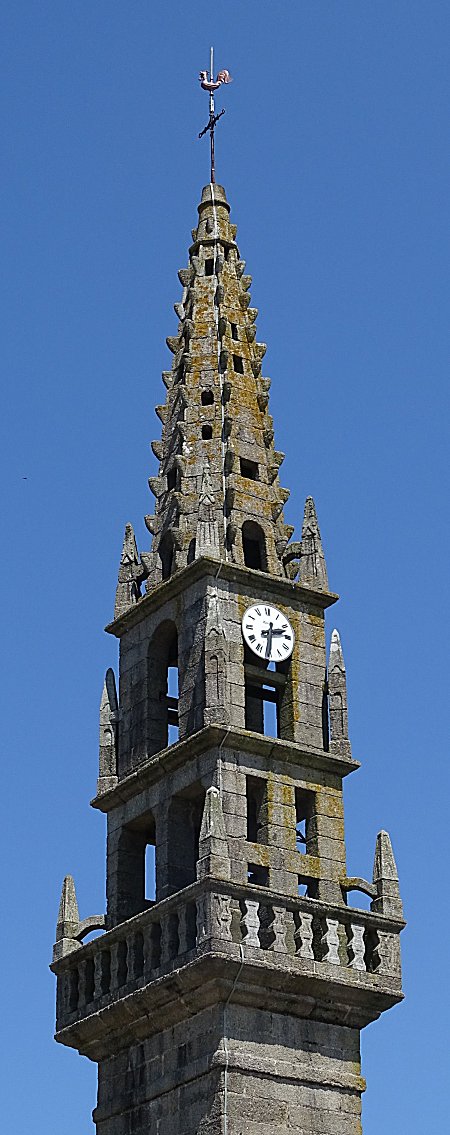
The spire of the bell tower, shot down by lightning in 1867, was immediately rebuilt identically.
To the left of the entrance gate you can see an old built-in holy water font and two blind semi-circular windows.
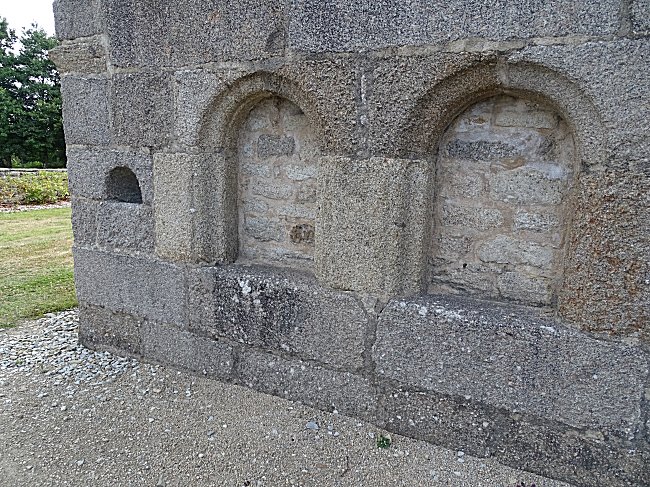
Behind them is the site of the old ossuary. In the past, as the bays were not closed, one could pray from the outside and throw holy water on the bones of the deceased who were stored there in order to reuse their graves.
Above the entrance gate is an inscription engraved in stone.
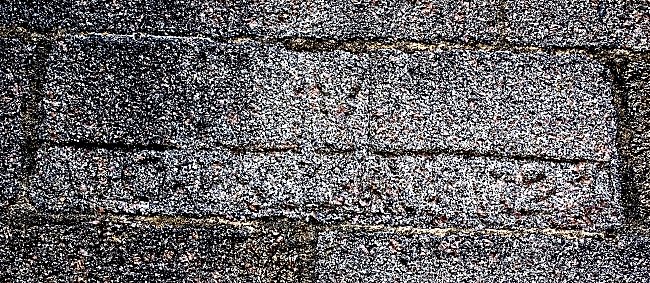
It's hard to read:
( Messire Gabriel Gléau, Recteur, 1727 )
This part of the building was renovated at the beginning of the XVIIIth century. Rector Gabriel Le Gléau had taken office in Lanrivoaré eight years earlier in 1719. We therefore owe him the works that had been entrusted to the architects Claude Burel and Gabriel L'Hostis.
The nave :
Access to the interior of the church is through a very sober porch at the foot of the bell tower.
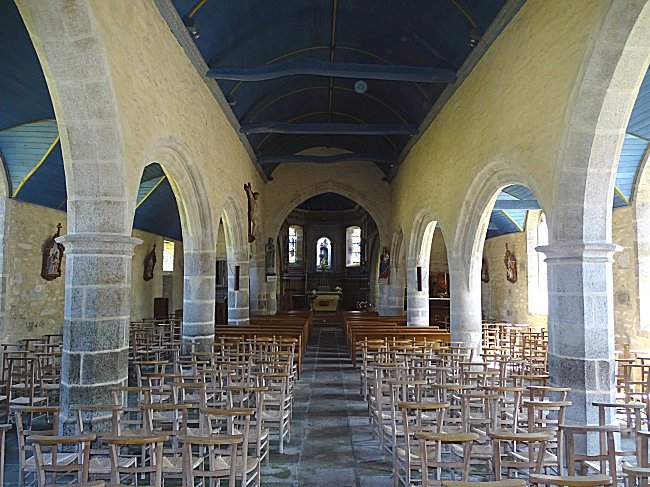
The nave has four bays with aisles and semicircular arches. The vault, panelled in cradle and painted blue, is equipped with visible beams of the same color.
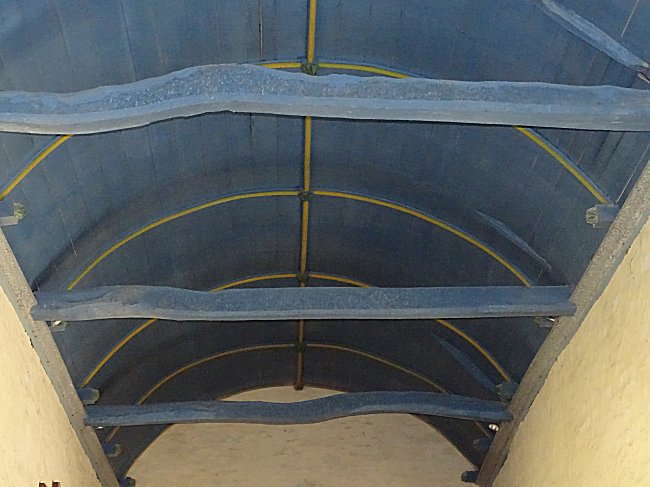
A high, shallow grandstand, painted blue, was built above the entrance.
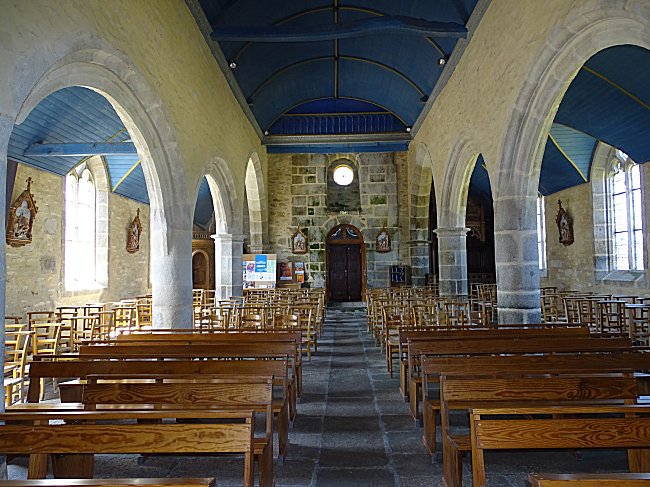
Let us take a look, on both sides of the entrance, at the confessional and the baptismal font.
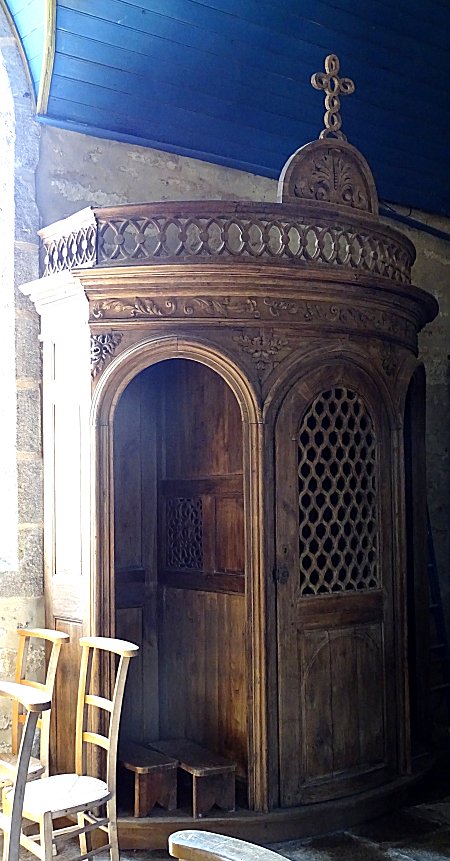
|
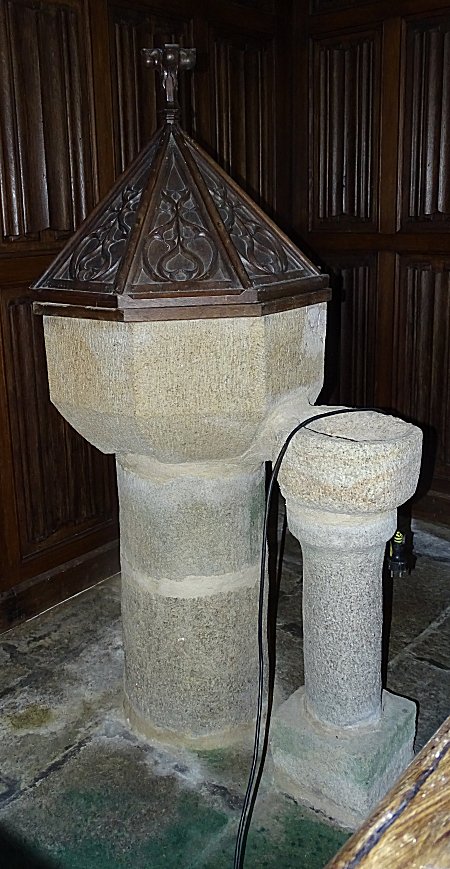
|
As in most churches, the stations of a Way of the Cross adorn walls of the aisles.
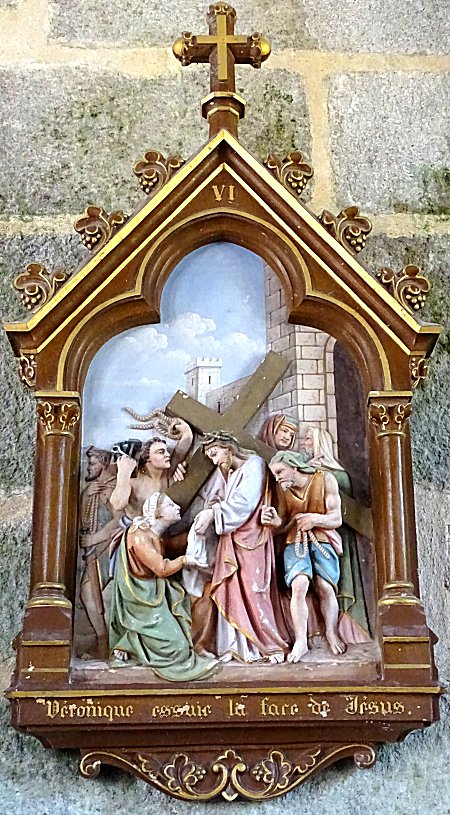
The chancel :
A flat chevet, with cut sides covered of panellings and pilasters, houses the chancel.
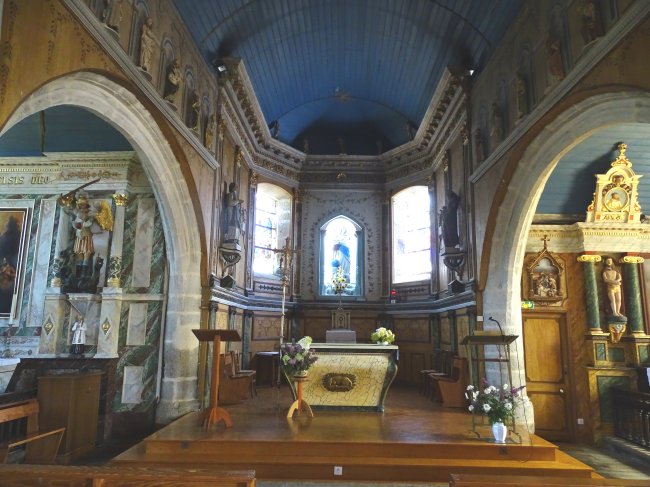
On these woodworks, one recognizes, in gilded appliques, pontifical coat of arms. In the center, in blue, an open book.
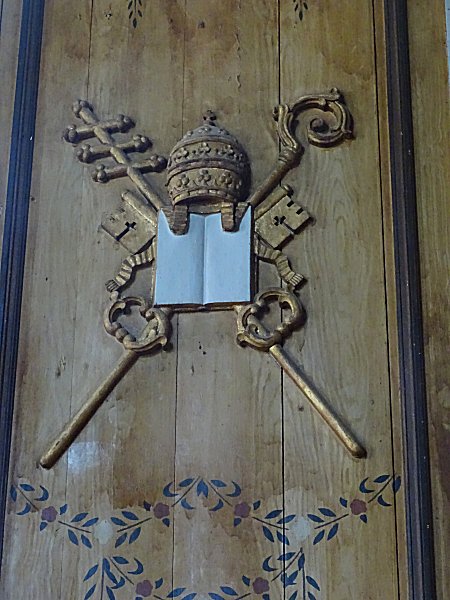
The altar, in the shape of a curved tomb, is dominated , in the niche of a window, by a Virgin and Child, as well as by the statues of Saint Rivoaré and Saint Herbot.
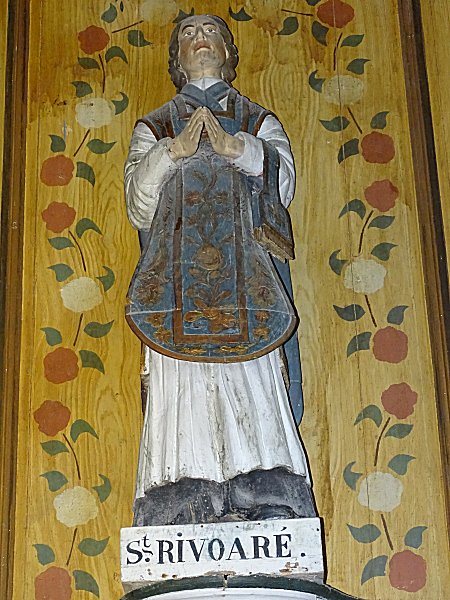
|
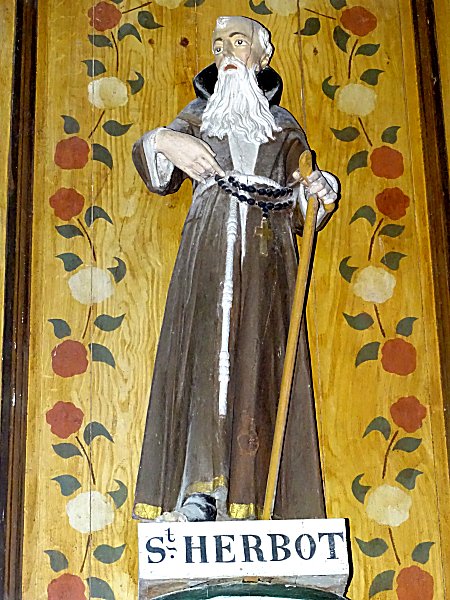
|
Saint Rivoaré, to whom the church is dedicated, is here at home. Saint Herbot's presence, however, requires some explanation. This saint, very popular in Brittany, would have come from across the Channel to VIth century. According to tradition, he lived as a hermit on the outskirts of Berrien, in the Monts d'Arrée, commanding obedience by wild animals with which he had conversations. He is venerated in rural areas as protector of horses and horned animals.
The stained-glass windows made in 1887 by the Lucien-Léopold Lobin workshop in Tours represent the Ascension and the Assumption.
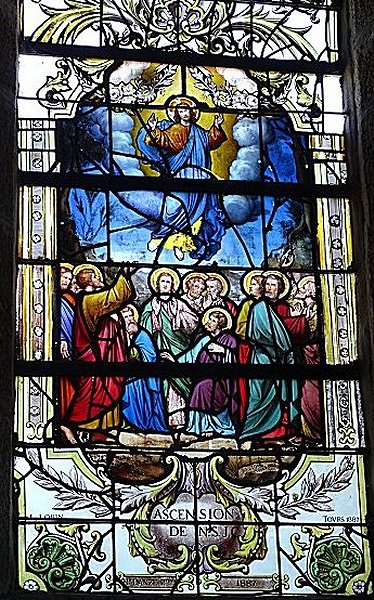
|
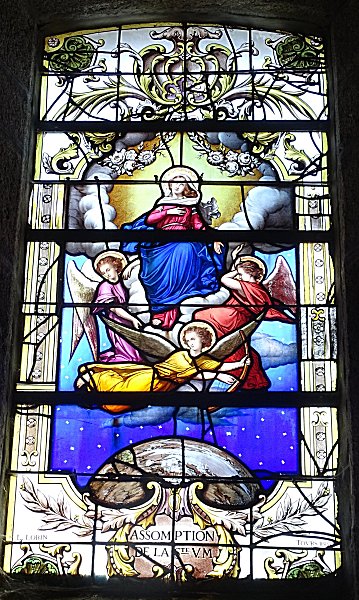
|
The transept :
It should also be noted that following work carried out in 2001, the heraldist Michel Mauguin was able to observe interesting details on the stained-glass window of the northeast transept that is hidden by an altarpiece.
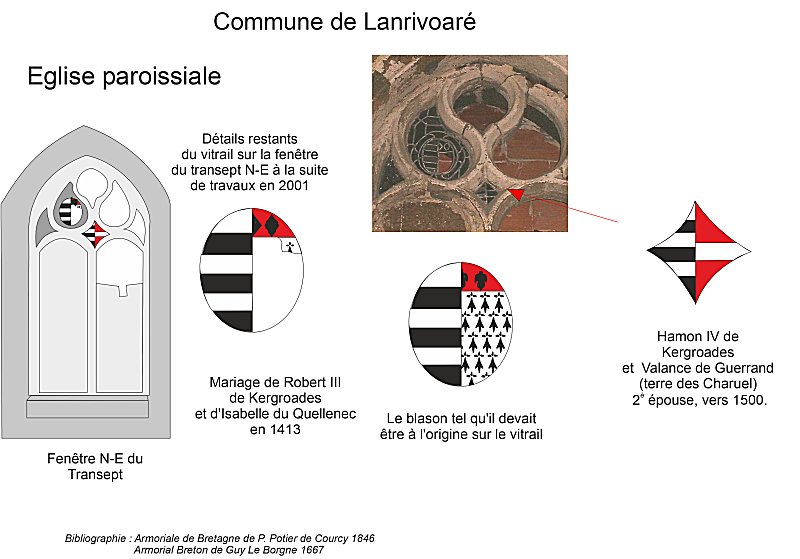
Document © Michel Mauguin
The marriages being well known, we see that the original stained-glass window dated from the XVth century.
At the crossing of the transept, one must look up to discover two beautiful carved cornices above the arcades where the statuettes of the twelve apostles are enthroned. Six on the right and six on the left.
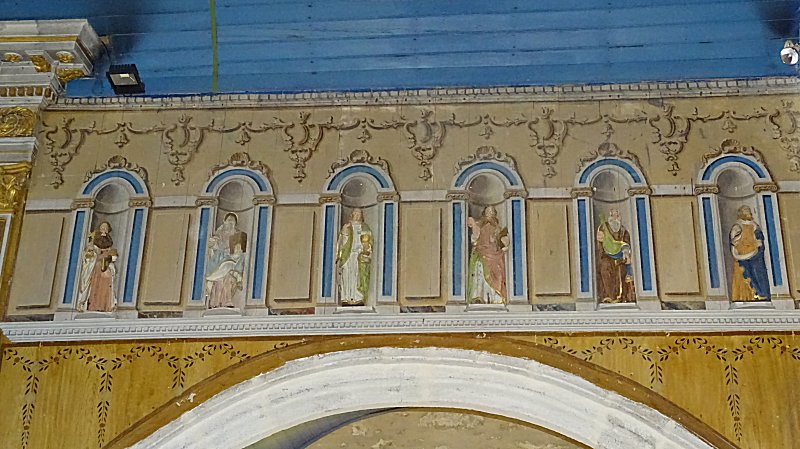
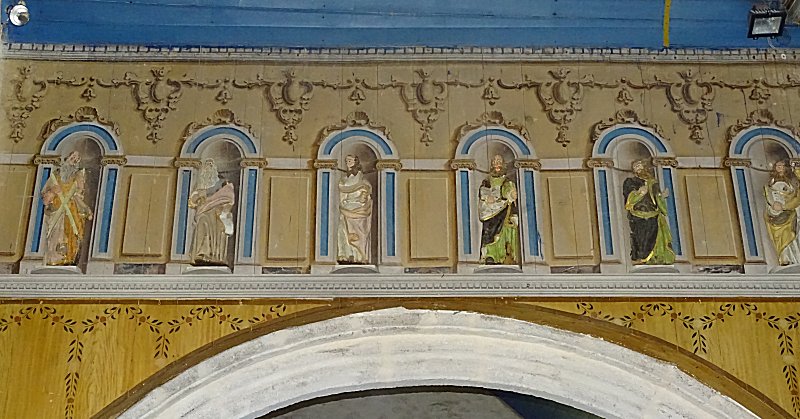
From ground level, their identification is difficult because only three carry accessories. St. Peter will be recognized by his key and St. Andrew by his cross. Imberbe, Saint John wears a chalice.
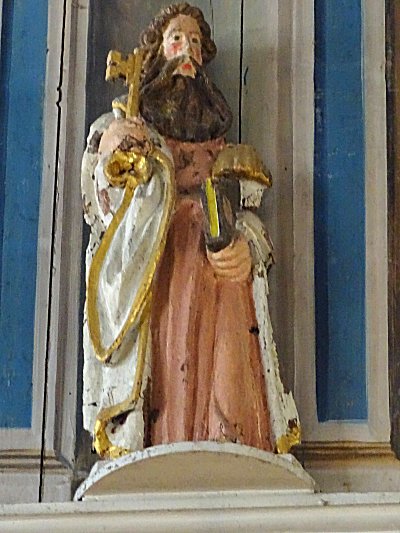
|
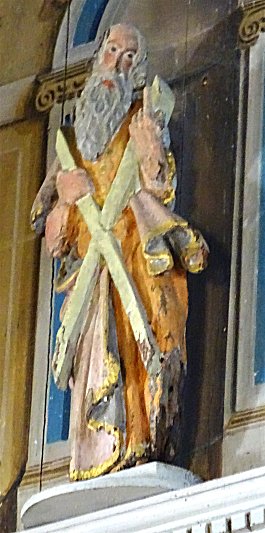
|
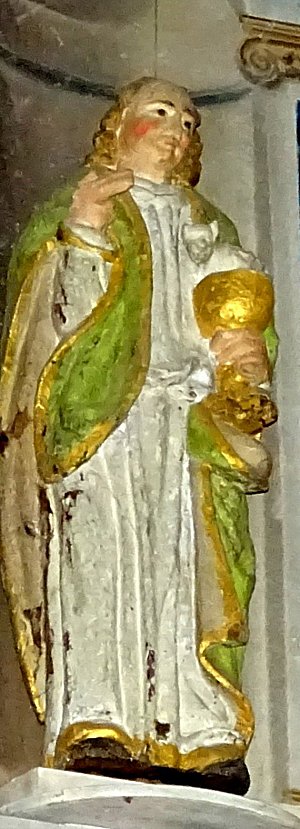
This entire frieze in polychrome wood dates from the 18th century and is probably the work of french Royal Navy craftsmen.
Imposing baroque altarpieces adorn the wings of the transept.
To the right, in the south wing, is a majestic baroque altarpiece with four smooth columns and entablature. In the center, a canvas represents Purgatory.
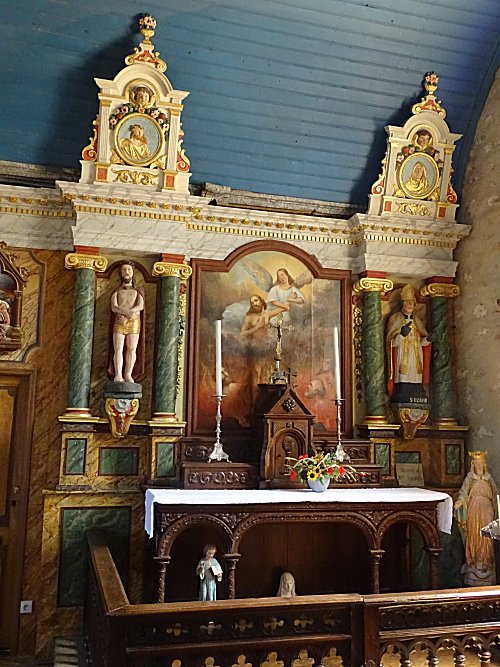
It is framed by two beautiful polychrome statues.
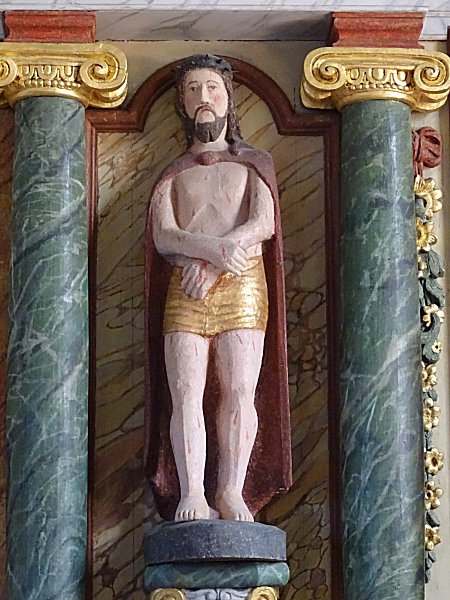
Christ in outrages |
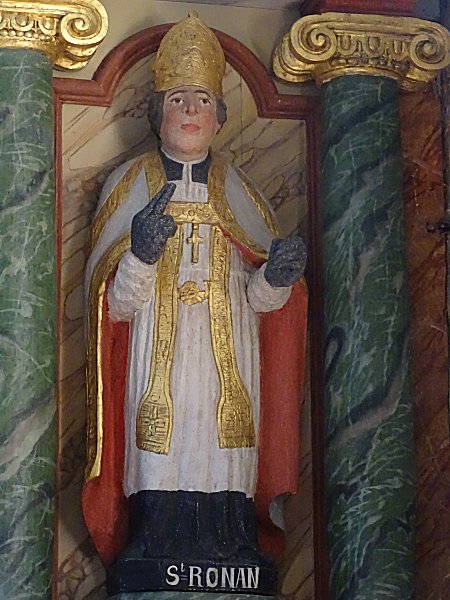
Saint Ronan |
Christ is represented wearing only a loincloth and a cape after his judgment.
Saint Ronan, of Irish origin, would have crossed the English Channel in the VIIth century in a stone trough and would have approached the Leonard shore. Gone back up the Aber Ildut river, he would have founded his hermitage at the place called Toul an Aon, not far from a spring, where today is the town hall of St-Renan. Later, he would have settled in Cornwall's country, at Locronan, probably on the emplacement of the present church which houses his tomb. Of course he is the patron saint of the St-Renan's parish, but also of Molène.
At the top of the entablature, two medallions show the busts in bas-reliefs of Christ and the Virgin Mary. A remarkable cabinet work !
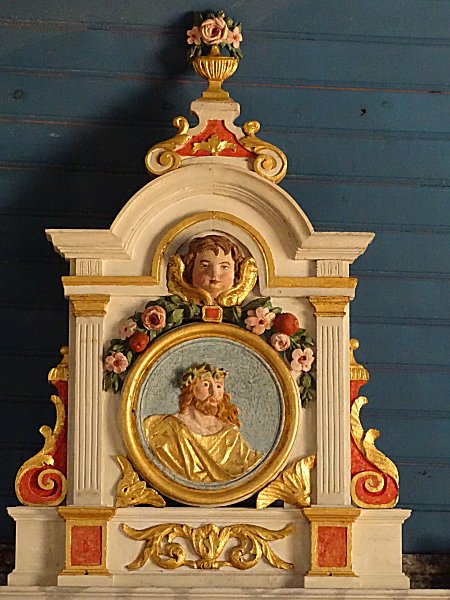
|
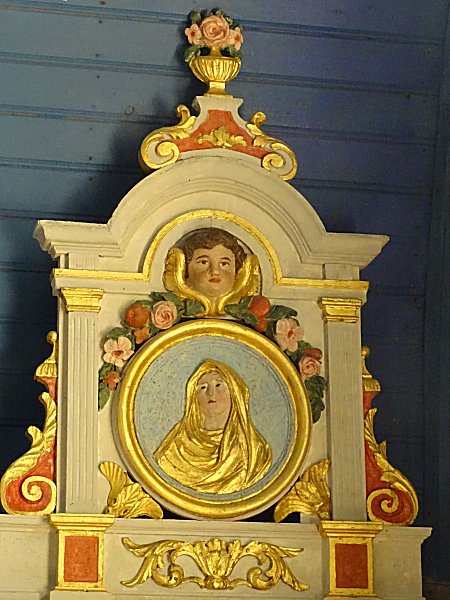
|
Opposite, in the north wing, the visitor discovers another altarpiece behind an altar to the glory of God ( Gloria in excelsis Deo). The painting depicts the Holy Trinity above a pope and a Bible character showing an Old Testament.
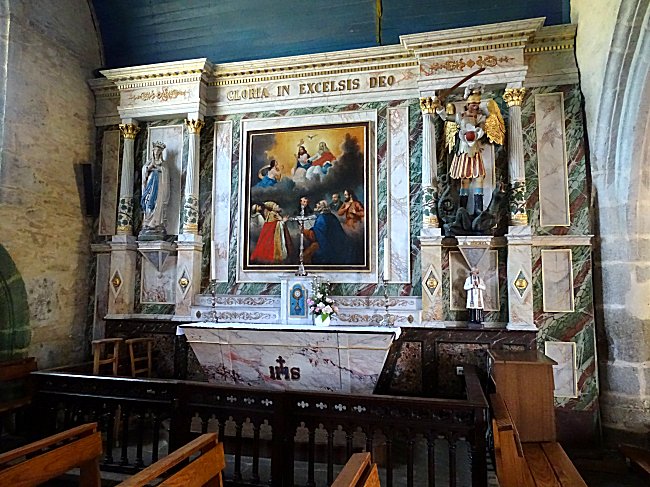
The altarpiece has four fluted columns framing on the left a statue of the Virgin Mary and on the right another of St. Michael knocking down the dragon of Evil.
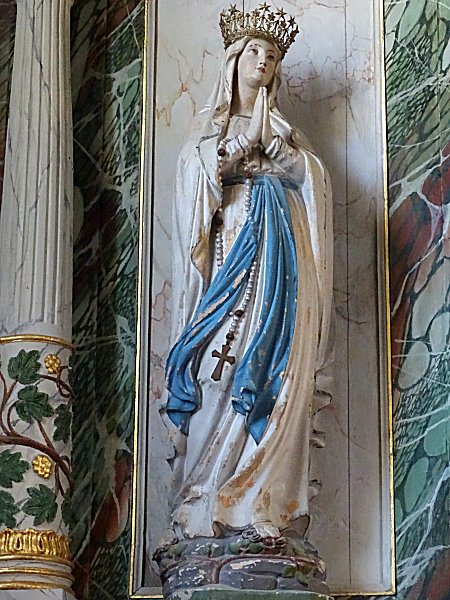
|
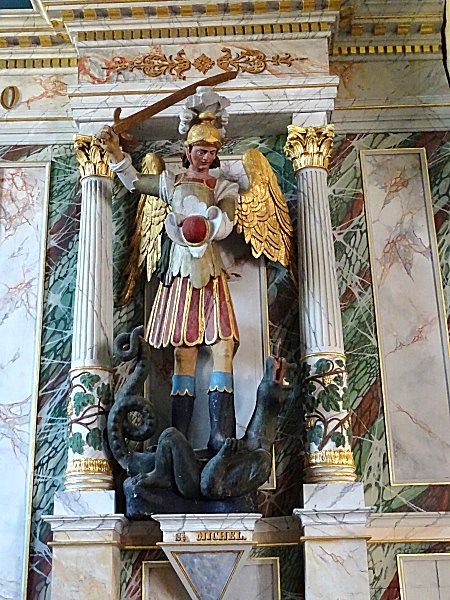
|
There is a small statuette next to the altarpiece:
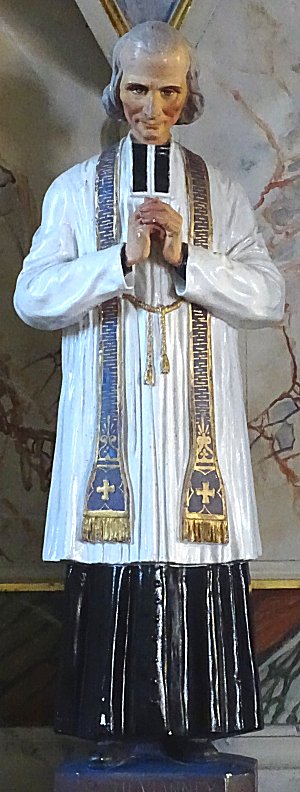
It is that of the parish priest of Ars, Saint Jean-Marie Vianney ( 1786 - 1859), canonized in 1925 and proclaimed by the pope patron saint of all the parish priests of the world in 1929.
One of our Internet users, Philippe Le Berre, discovered in the Departmental Archives of Finistère an article from 1873 concerning the maintenance of the church furniture. We cannot resist the pleasure of reproducing it below, as it will certainly amuse you:
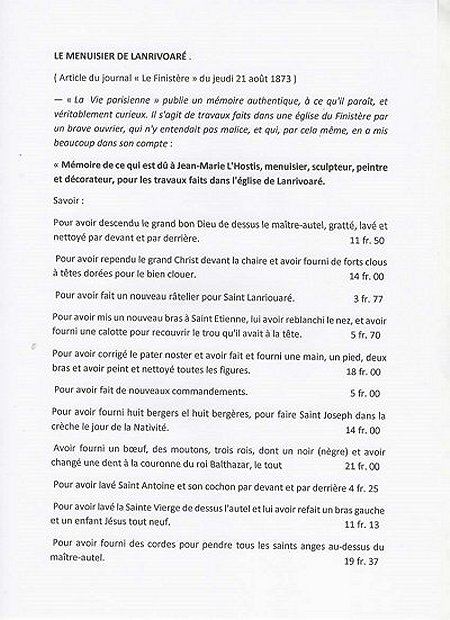
|
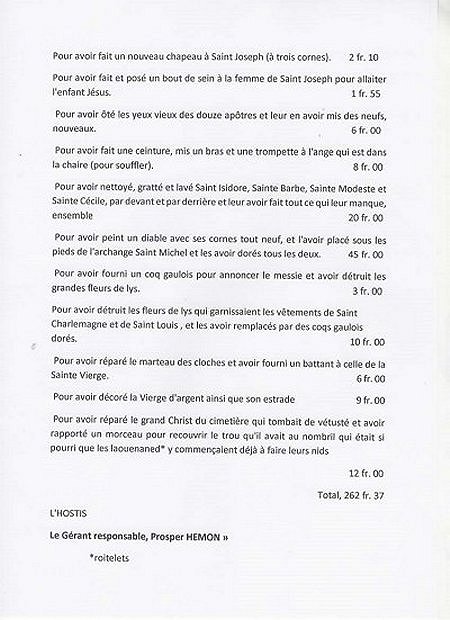
|
Since 1873 the furniture of the church has evolved. However, you may enjoy looking for what remains today of the repairs made by this local craftsman.
Outside, be sure to lean over an engraved stone placed standing near the church gate. It is a Gallic stele 2500 years old whose inscription is still legible.
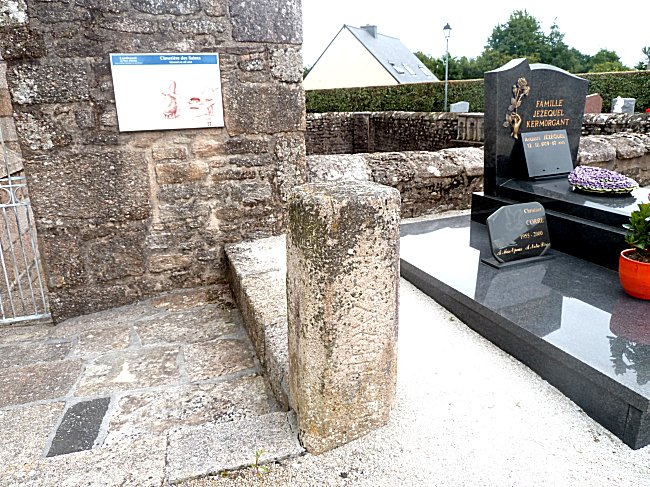
And further on, on the south face of the building, an old sundial, very interesting, just needs to be observed carefully.
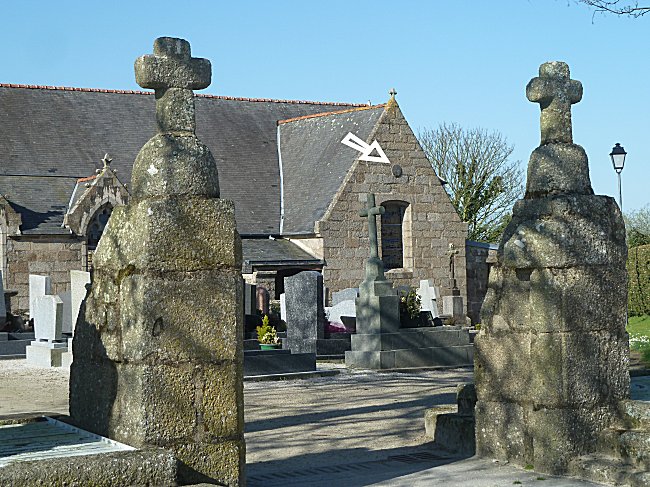
You will discover the details on two special pages of this website:
(
The engraved stele of the Saints Cemetery )
(
Lanrivoaré's sundial )
The calvary of the cemetery also deserves a glance :
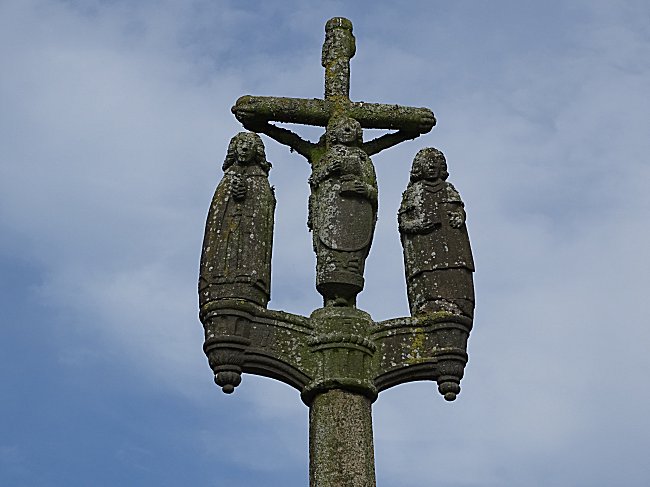
There are two twin statues and on the reverse of the crucifix, that of Saint Rivoaré in priestly ornaments. This calvary dates from 1632.
-1-
In Brittany, we call "échalier" the access to an enclosure which obliges to step over a flat stone placed on edge. This device was intended here to prevent animals from entering the cemetery. We can also think that by imposing an effort on humans, it symbolized the difficulty of passing from the world of the living into the kingdom of the dead. There are still "échaliers" around some wash-houses or defending access to a well like the St-Ronan well in Molène.
(
The wash-houses the country of Iroise ) (
The St-Ronan well )
Thanks to Philippe LE BERRE who sent us the article about the carpenter of Lanrivoaré.
READ MORE
Thanks also to Michel MAUGUIN who carried out heraldic research on the lords of Kergroadez and kindly authorized us to put them below at the disposal of the Internet users.




